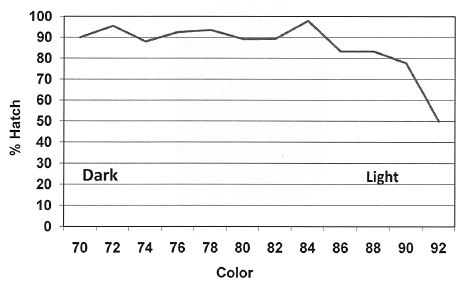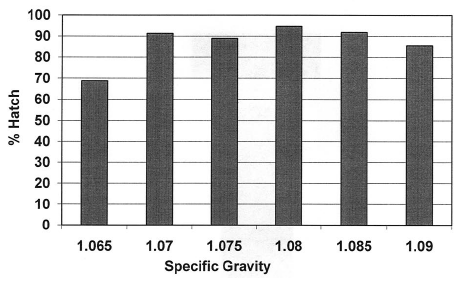Clearly hatchability is important to both small flock and commercial poultry breeder flock owners. Maintaining hatching egg shell quality is important because of its connection with hatchability. The major factors that influence egg shell quality are genetics, diet, climate, housing and age of the hens. While the average poultry operation has limited control over most of these factors, the crucial significance of hatchability makes it is important to recognize and control egg shell quality where possible.
Obviously, eggs with thin shells are more likely to break, producing 'leakers.' While leakers are not usually set in the incubator, thin shelled eggs crack easily in the hen house, during collection and transportation, resulting in poor hatches due to contamination. In addition to the increased likelihood of shell breakage, thin shelled eggs that do not suffer breakage allow for higher water vapor loss during the entire incubation process resulting in dehydration and higher embryonic mortality. Those chicks that do hatch from thin shelled eggs have decreased livability during the first few days of life and poor overall performance because they get off to a slow start.
Egg shell color has also been questioned in regards to its affects on hatchability. While the scientific literature contains conflicting data regarding the relationship between egg color and hatchability, poultry producers have long held the belief that in typical brown egg laying breeds, light colored eggs will not hatch as well as those that are darker in color. Indeed, it is interesting to note that in certain songbird species (flycatchers) experimental evidence suggests that healthier more wellfed females lay more intensely colored eggs (Moreno et al., 2006). Thus, there is some evidence to substantiate the assumption that darker eggs hatch better than lighter colored eggs. Eggshell color may also be associated with egg shell quality. Therefore, producers have been trained to eliminate light colored eggs from consideration as hatching eggs due to their poorer hatching expectations.
Measuring shell quality: Determining shell quality involves estimating shell thickness. Although there are many methods for estimating shell thickness, egg specific gravity is the easiest and most widely utilized. There are two methods to obtain egg specific gravity measurements: the Archimedes method and the salt solution method.
The Archimedes method involves weighing eggs individually and then weighing the egg in water. Then the formula [dry egg weight/ (dry egg weight-wet egg weight)] is used to obtain the specific gravity. However, because eggs must be individually weighed, this method is seldom used. The salt bath method utilizes tubs of water each of which contains a greater concentration of salt than the previous tub (typical concentrations are 1.070, 1.075, 1.080, 1.085 and 1.090). The specific gravity of the solution in which the egg floats, is the specific gravity of the egg. Eggs are placed initially in the tub with the lowest salt solution concentration. The specific gravity estimate is recorded for those eggs that float. Those eggs that do not float are removed and placed into the next higher solution and so forth until all the eggs float. This method is popular because it allows for rapid measurement of large numbers of eggs, with minimal affect on the eggs or their hatchability. The best time to measure specific gravity is in the hatchery after the eggs have had a chance a constant temperature and to reach the same temperature as the salt solutions.
Measuring shell color: The shells of broiler breeder eggs can vary from white to almost chocolate in color. The cause of this variation in egg color is not known, but eggshell color measurements have been made using techniques ranging from visual estimation to sophisticated electronic measurements. However, digital colorimeters are generally best because they tend to remove the subjectivity from these measurements.
Experimental Procedures
Egg Selection and Handling: A total of 1,944 eggs were collected from five different broiler breeder flocks that were between 33 and 45 weeks of age. Eggs were labeled so that each egg individually could be followed through the testing, incubation and hatching process. For this study, cracked eggs, toe checked eggs and any misshapen, too small or large eggs, or dirty eggs were eliminated. Only eggs that would be acceptable hatching eggs by the commercial integrator were used. Eggs were hatched at the commercial hatchery using industry standards and after hatch, a hatch residue breakout was performed to determine fertility and time of embryonic mortality.
Specific gravity: Salt solutions were maintained in the egg storage room at a local commercial hatchery and measured after they had time to adjust to the temperature of the room. The salt solutions were check regularly for accuracy with a hydrometer and concentrations ranged from a low of 1.065 to a high of 1.090 in increments of 0.005.
Shell color: Eggshell color was determined for each egg using a colorimeter that gave a numeric measurement of shell color. This procedure removed human error from shell color determinations. Pure white eggs would have returned a reading of 100, while darker eggs had lower numbers. The eggs that were measured had a color range from upper 60's (dark) to the lower 90's (light colored).
Experimental Results
Specific Gravity and Hatch: Hatchability results are shown in Figure 2. These results indicate that eggs with a specific gravity of 1.070 hatch as well as those with higher specific gravities and that hatch is not negatively affected until specific gravity is 1.065 or lower. These results are different than those published by McDaniel et al., 1981 and Bennett, 1992, who report that eggs with specific gravities less than 1.080 had poor hatch and increased embryo mortality. This difference in results may be the result of genetic progress made during the last 15 years, or in experimental methodology.
Shell Color and Hatch: Figure 1 shows the relationship of how shell color relates to hatchability. These results show that the hatch of extremely light colored eggs is lower than the darker eggs. Since shell pigments are applied to the shell just prior to the egg being layed light egg color may be a sign of prematurely layed eggs caused by some type of environmental stress.
Summary
1. A measurement of specific gravity can be effectively used to rapidly evaluate the shell quality in broiler breeders.
2. Eggs with specific gravity values higher than 1.070 will hatch well while those lower will result in poor hatches and indicate poor shell quality.
3. Lighter colored eggs (color scores above 87) hatched at a lower rate than did darker eggs. However, the light colored eggs would be considered those which are 'extremely light' and not just a lighter shade.
References
Bennett, C.D. 1992. The influence of shell thickness on hatchability in commercial broiler breeder flocks. Journal of Applied Poultry Research 1:61-65.
McDaniel, G.R., J. Brake and M.K. Eckman. 1981. Factors affecting broiler breeder performance. 5. The interrelationship of some reproductive traits. Poultry Science 60:1792-1797.
Moreno, J., E. Lobato, J. Morales, S. Merino, G. Tomas, J. Martinez-de la Puente, J. J. Sanz, R. Mateo and J. J. Soler. 2006. Experimental evidence that egg color indicates female condition at laying in a songbird. Behavioral Ecology 17:651-655.
Figure 1. Hatchability of Commercial Eggs by Egg Shell Color Code.

Figure 2. Hatchability of Commercial Eggs by Specific Gravity Using the Salt Solution Method.













.jpg&w=3840&q=75)